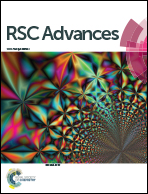Effect on ceramic grade CaF2 recovery quality from the etching wastewater under the optimum sulfate content†
Abstract
The improvement of fluorite quality is an attractive measure to recover fluoride from high F− content wastewater and thus reduces the fluorite sludge generation rate, and the removal of contaminant pollutants could be helpful for the production of ceramic grade fluorite (>85%). In this work, typical etching wastewater was collected and characterized, and SO42− was found to be the main barrier for high quality CaF2 production, while CaSO4 could also contribute to CaF2 precipitation. The optimum SO42− content was adjusted by the introduction of barium salts, to keep a balance between the CaF2 quality and the settlement process. The ceramic grade CaF2 of 88% was obtained under the conditions: [Ca]/[F] of 1.29, pH 8.14 and Csulfate of 117.4 mg L−1. The residual SO42− content should be kept in the range of 100–130 mg L−1, and the formation of CaSO4, combined with CaF2 could accelerate the CaF2 precipitation by the co-precipitation method, with a larger particle size from 758 nm (without SO42−) to 898 nm. The gradient settlement of CaF2 contributes to the recovery of fluoride from etching wastewater, while CaF2 preparation should be carried out in a dynamic experiment, such as a fluidized bed, for further research.


 Please wait while we load your content...
Please wait while we load your content...